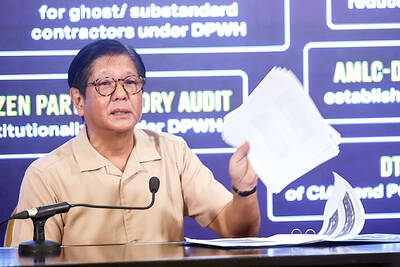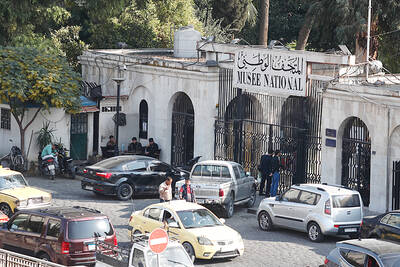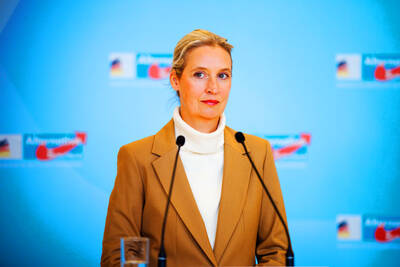Astrophysicists yesterday published the largest-ever 3D map of the universe, the result of an analysis of more than 5 million galaxies and ultrabright, energy-packed quasars.
The efforts of hundreds of scientists from about 30 institutions worldwide have yielded a “complete story of the expansion of the universe,” Will Percival of the University of Waterloo in Ontario, Canada, said.
In the project launched more than two decades ago, the researchers made “the most accurate expansion history measurements over the widest-ever range of cosmic time,” he said in a statement.

Photo: AFP / Swiss Federal Institute of Technology Lausanne
The map relies on the latest observations of the Sloan Digital Sky Survey, titled the “extended Baryon Oscillation Spectroscopic Survey” (eBOSS), with data collected from an optical telescope in New Mexico over six years.
The infant universe following the Big Bang is relatively well known through extensive theoretical models and observation of cosmic microwave background — the electromagnetic radiation of the nascent cosmos.
Studies of galaxies and distance measurements also contributed to a better understanding of the universe’s expansion over billions of years.
However, Kyle Dawson of the University of Utah, who unveiled the map, said the researchers tackled a “troublesome gap in the middle 11 billion years.”
Through “five years of continuous observations, we have worked to fill in that gap, and we are using that information to provide some of the most substantial advances in cosmology in the last decade,” he said.
Astrophysicist Jean-Paul Kneib of the Swiss Federal Institute of Technology in Lausanne, who initiated eBOSS in 2012, said the goal was to produce “the most complete 3D map of the universe throughout the lifetime of the universe.”
For the first time, the researchers drew on “celestial objects that indicate the distribution of matter in the distant Universe, galaxies that actively form stars and quasars.”
The map shows filaments of matter and voids that more precisely define the structure of the universe since its beginnings, when it was only 380,000 years old.
For the part of the map relating to the universe 6 billion years ago, researchers observed the oldest and reddest galaxies.
For more distant eras, they concentrated on the youngest galaxies — the blue ones. To go back even further, they used quasars, galaxies whose supermassive black hole is extremely luminous.
The map reveals that the expansion of the universe began to accelerate at some point and has since continued to do so.
The researchers said this seems to be due to the presence of dark energy, an invisible element that fits into Albert Einstein’s general theory of relativity, but whose origin is not yet understood.
Astrophysicists have known for years that the universe is expanding, but have been unable to measure the rate of expansion with precision.
Comparisons of the eBOSS observations with previous studies of the early universe have revealed discrepancies in estimates of the rate of expansion.
The currently accepted rate, called the “Hubble constant,” is 10 percent slower than the value calculated from the distances between the galaxies closest to us.

Philippine President Ferdinand Marcos Jr yesterday vowed that those behind bogus flood control projects would be arrested before Christmas, days after deadly back-to-back typhoons left swathes of the country underwater. Scores of construction firm owners, government officials and lawmakers — including Marcos’ cousin congressman — have been accused of pocketing funds for substandard or so-called “ghost” infrastructure projects. The Philippine Department of Finance has estimated the nation’s economy lost up to 118.5 billion pesos (US$2 billion) since 2023 due to corruption in flood control projects. Criminal cases against most of the people implicated are nearly complete, Marcos told reporters. “We don’t file cases for

Ecuadorans are today to vote on whether to allow the return of foreign military bases and the drafting of a new constitution that could give the country’s president more power. Voters are to decide on the presence of foreign military bases, which have been banned on Ecuadoran soil since 2008. A “yes” vote would likely bring the return of the US military to the Manta air base on the Pacific coast — once a hub for US anti-drug operations. Other questions concern ending public funding for political parties, reducing the number of lawmakers and creating an elected body that would

‘ATTACK ON CIVILIZATION’: The culture ministry released drawings of six missing statues representing the Roman goddess of Venus, the tallest of which was 40cm Investigators believe that the theft of several ancient statues dating back to the Roman era from Syria’s national museum was likely the work of an individual, not an organized gang, officials said on Wednesday. The National Museum of Damascus was closed after the heist was discovered early on Monday. The museum had reopened in January as the country recovers from a 14-year civil war and the fall of the 54-year al-Assad dynasty last year. On Wednesday, a security vehicle was parked outside the main gate of the museum in central Damascus while security guards stood nearby. People were not allowed in because

A feud has broken out between the top leaders of the far-right Alternative for Germany (AfD) party on whether to maintain close ties with Russia. The AfD leader Alice Weidel this week slammed planned visits to Russia by some party lawmakers, while coleader Tino Chrupalla voiced a defense of Russian President Vladimir Putin. The unusual split comes at a time when mainstream politicians have accused the anti-immigration AfD of acting as stooges for the Kremlin and even spying for Russia. The row has also erupted in a year in which the AfD is flying high, often polling above the record 20 percent it